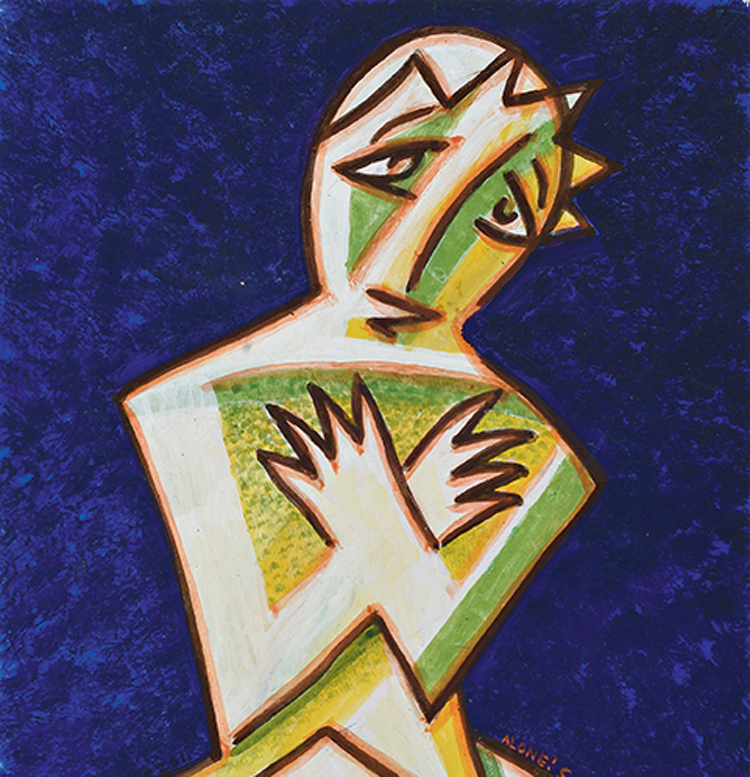If eyes are indeed the windows of the soul, Sanat Kar’s paintings lay bare the artist’s psyche. In a career spanning more than five decades, eyes have remained central to Kar’s aesthetics — whether in the sparse lines of his pioneering wood intaglios or in the sprite-like figures that flit across his paintings done in tempera and other media. It is these wide eyes, filled simultaneously with fear and wonderment, that stay with the viewer long after leaving Sanat Kar: a retrospective (1963 -2017), CIMA’s tribute to this veteran artist who revolutionized printmaking by experimenting with inexpensive media like wood and cardboard.
The eyes of the artist, however, remain averted, engrossed in work in the larger-than-life photograph that greets the viewer on stepping into the gallery; before it lies a charming mock-up of the artist’s studio, with a diverse assortment of knick-knacks ranging from a banal broom to art books and supplies. With this peek at the magician behind the scene, the stage is set for the unfolding of the panorama of Kar’s life’s work. Oscillating meaningfully between figures and linear abstraction, Kar’s etchings, as well as his wood and cardboard intaglios, are pervaded by a sense of brooding contemplation. The spare yet fluid lines encasing the figures are spontaneous yet fitful, while the artist plays with negative space and free-flowing cross-hatching to create a mysterious and sullen atmosphere around them. At other times, solemn shades of turquoise mix with neutral greys or earthy tones to envelop figures, insulating them from the rest of the world. The most wonderful instance of this is Mother, in which it takes Kar just two lines and two circles surrounded by a sea of blue to suggest the depth of the bond between mother and child, a protective embrace and a moving picture of unity against a world of shadows.

‘Alone!’ (2011), a tempera by Sanat Kar Source: CIMA
The mid-1970s brought structure and detail to Kar’s work as is evident in Ravan, where geometric shapes are pieced together to highlight both the light and the darkness hidden in the king of Lanka, with strikingly intricate details marking out his heads and piercing gaze. The same attention to intricacy is evident in his illustrations from the Baishnab Padaboli, while pieces like Sati and Baul combine languid but orderly lines with cleverly juxtaposed colour to dramatic effect. By the late 1970s, Kar achieved mastery of the new media and techniques of printmaking that he had devised and started creating, side by side, dark, monotonal spectral figures and his signature one-dimensional, delicate beings huddled together like friends who have forged a kinship born of despair. In his hands, even inanimate objects are turned into sentient beings where cups, furniture and clothes sprout eyes, hands and legs and are ‘arranged’ in a surreal tableau as in the Ikebana series.
While his style evolves, some traits remain constant. Foremost among these is a sense of isolation. Although an acute feeling of being an outsider is evident right from the beginning, the artist progressively finds himself more alone. Even when the frames are teeming with beings, each character stands apart. By 2011, even though Kar had been crowned by fame, he found himself completely Alone!.
A discerning viewer will also find glimpses of other artists who inspired Kar, who pays the occasional understated tribute to Cézanne’s reduction of forms into their geometric essentials (Waves) or Picasso’s cubist perspectivism (King). Kar’s work also embodies the sensibilities of his Bengal school predecessors like Kshitindranath Majumdar. Adding depth to our understanding of the artist’s character are his book, Golpo Noy Goppo, and personal sketchbook, that have been thoughtfully displayed alongside his art.










